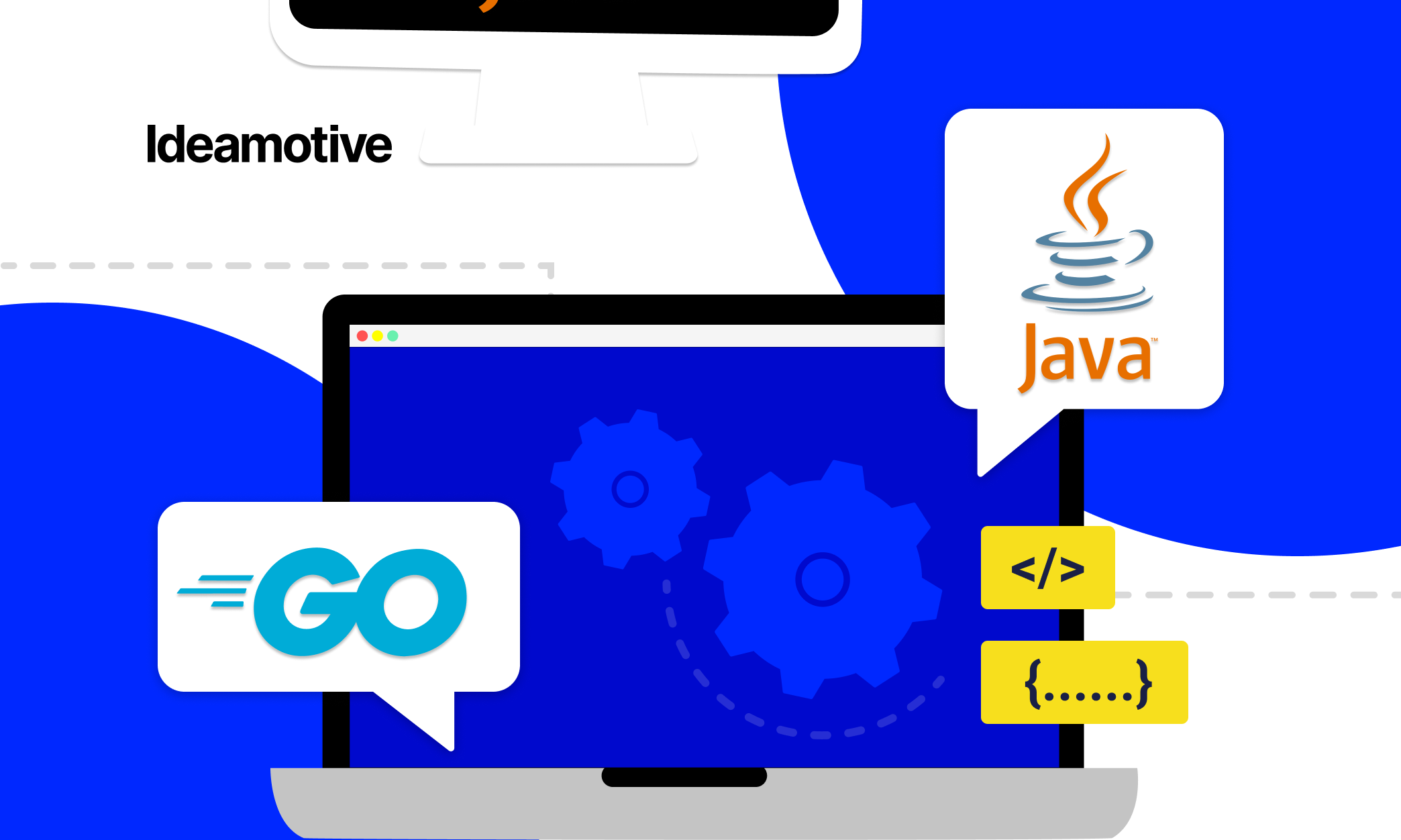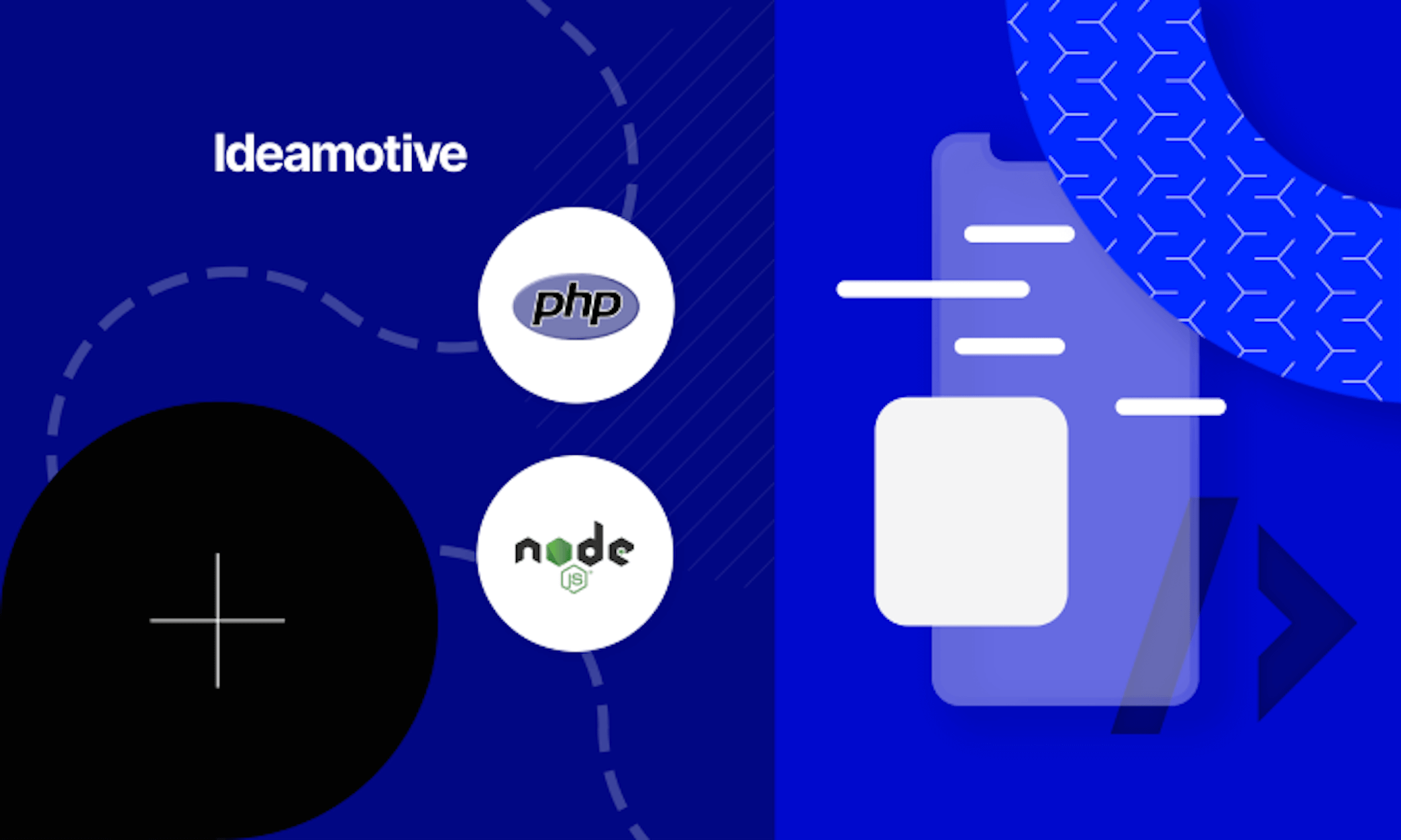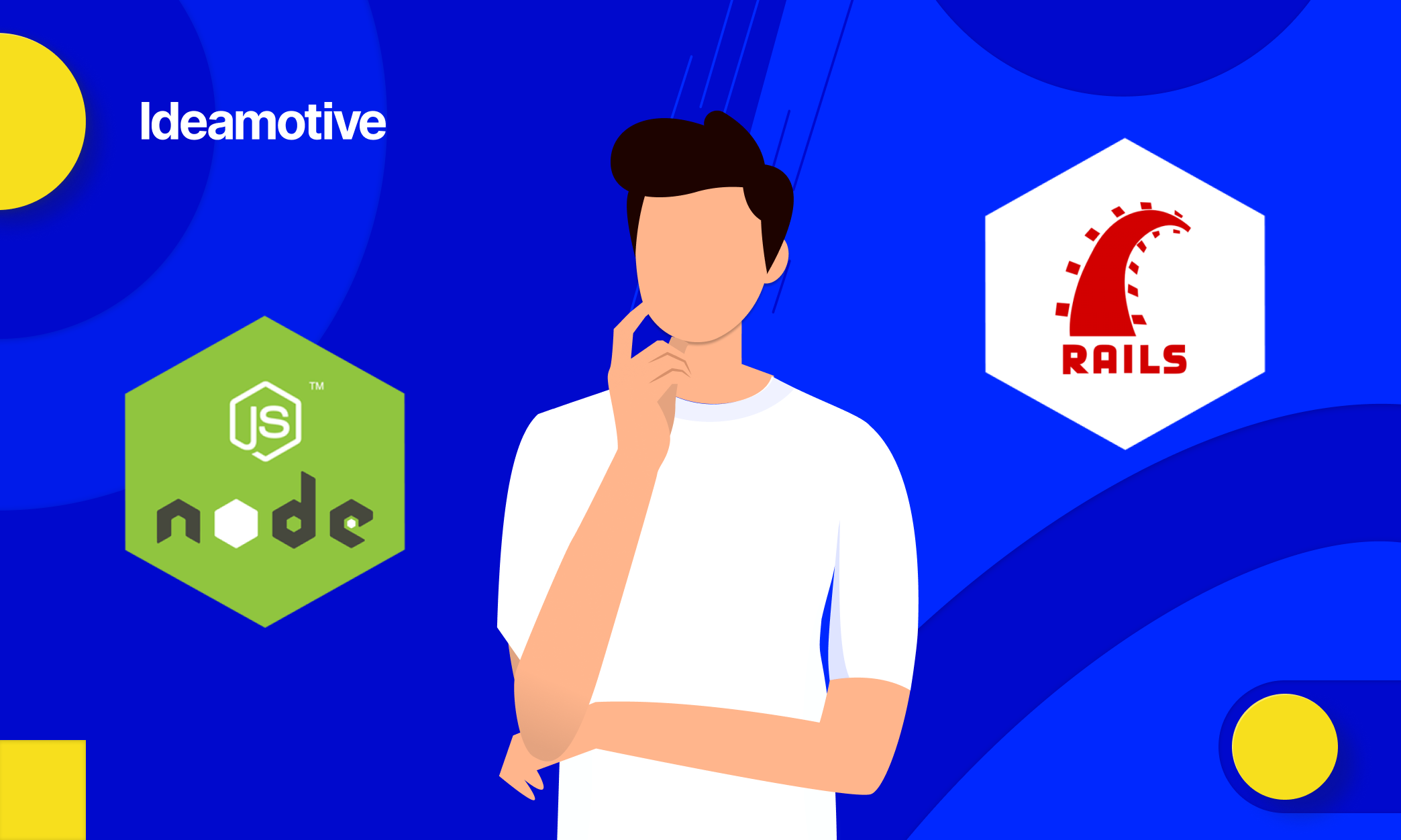One of the biggest dilemmas a product owner confronts while managing a software development project is how to choose backend technology. There are three fundamental things behind the choice:
- your business priorities and objectives
- the specifics of your business domain and market
- the specifics of technology itself.
The server side of your future product is arguably its most important part. There are a few dozens of languages available on the market and the number is changing every year. To make your navigation in the maze of modern web development easier our talented web developers prepared a list of six coding systems considered the best backend languages. We recommend considering such backend solutions as Python, Java, JavaScript, PHP, Ruby, and Golang.
.png?width=1584&name=Python_%20The%20Definitive%20Business%20Guide%20-%20blog%20banner%201584x396%20(1).png)
Python

Introduced in 1991 Python gained popularity as one of the easiest programming languages to get acquainted with. Throughout the years it gathered numerous communities supporting the advancement of Python libraries and frameworks. According to the PYPL PopularitY of Programming Language Index Python is the most popular programming language in the world.
By now Python is used by a variety of IT companies, such as Instagram social network, Spotify streaming service, Instacart grocery delivery company, Lyft rideshare company.
The most beloved Python’s traits are:
- The simplicity of syntax
- Fast prototyping
- A rich ecosystem of pre-ready code samples
- Scalability.
Simple syntax
Among other backend languages, Python gained a reputation as the easiest to learn. It has a simple syntax similar to the English language which makes Python code comprehensible even for amateurs. Nevertheless, such simplicity doesn’t restrain Python’s productivity. Trained developers can turn it into a powerful tool capable of complex calculations.
Fast prototyping
With fewer lines of code, the Python programming language is fast, making it ideal for getting things to market quickly. It is mostly used for minimum viable, mid-sized, and large products. Brief development time shortens the distance between feedback and implementation of improvements allowing your product to evolve at a cougar pace.
Python’s libraries and frameworks
One of the biggest Python’s treasures is a voluminous collection of library tools and packages, which allows access to much pre-written code, streamlining your application development time. For example, you have access to Pillow for image processing, Bcrypt for generating strong hashing values, Matplotlib and Seaborn for data visualization, SLQALchemy for composable queries, etc. From the variety of available pre-written code samples, we consider Django as the best backend framework.
Scalability
There are several tools available in Python ensuring the scalability of the product. First of all, Python supports powerful data containers for ‘collections’ such as dict, list, set, and tuple. Second, Python provides a number of generator functions that allow you to create efficient iterators. Generators are also a beneficial instrument for encapsulation of methods and variables that provides new and useful ways for you to package and isolate the internal code dependencies. This is why you can use generators for loops.
Python’s disadvantages:
Despite its benefits, Python has a number of disadvantages:
- It is not suitable for mobile computing;
- It is slower by virtue of being an interpreted programming language;
- The database access layer is immature;
- Python is highly dependent on 3rd party frameworks and libraries;
- If the application is interrupted, the execution time becomes very slow.
Java

Another popular choice for back-end development is Java – a class-based, object-oriented programming language with syntax deriving from C++. It was developed during the early 1990-s by Sun Microsystems (acquired by Oracle in 2010) and was released to the market first in 1996.
It is widely used for building enterprise-scale web applications as it is one of the most stable languages on the market. Java’s advantages include platform independence, multi-threaded processing, automatic garbage collection, and security.
Cross-platform
Java was developed with the “Write Once, Run Anywhere” approach in mind, meaning that the code written in Java can be run on any platform, regardless of where it was originally created. Such platform independence is provided by Java Virtual Machine – the environment where Java code is executed. In this respect, Java is different from other languages that require compilers.
Multi-threaded Processing
A great Java’s feature is the use of a multi-threaded web server. Such a server processes each request in an independent thread. This feature allows avoiding queueing of the events by executing requests concurrently. For this reason, Java is a great tool for CPU-overloading tasks, such as transcoding a video, compressing files, financial modeling, etc.
Security
Java is said to be more secure than any other programming language. Its security is obtained from a large set of APIs, tools, and implementations of commonly-used security algorithms, mechanisms, and protocols. A vital role is played by the abovementioned Java Virtual Machine (JVM) that verifies the byte-code. The JVM provides guarantees that there is no unsafe operation going to execute. Other Java’s security mechanisms beloved by professionals include cryptography, public key infrastructure, secure communication, authentication, and access control.
Java’s disadvantages:
While being a reliable and steady backend language, Java has some drawbacks:
- The creation of high-quality data structures is limited by the absence of templates;
- Memory management is expensive;
- Due to the extra level of compilation and abstraction by the Java Virtual Machine the performance is rather slow;
- Commercial use of Java requires the purchase of a license from Oracle;
- Java doesn’t provide a backup facility.
JavaScript and its runtime environment, Node.js

Alongside HTML and CSS, JavaScript is one of the core technologies of the World Wide Web. Introduced in 1995, it was mainly used for frontend development until the release of the Node.js runtime system in 2009. The new runtime allowed the execution of JavaScript code outside the browser. Server-side scripting appeared to be efficient in the production of dynamic web page content which gives a website a richer interface.
Choosing Node.js is a wise decision if you are developing games, chats, streaming services or Internet of Things products. It also suits well for microservice-based products. Such Node.js utility is accomplished by such characteristics as support of a non-blocking input-output and a significant number of connections.
Concurrency
One of the key features of JavaScript’s Node.js is the use of non-blocking input-output which provides concurrency. JavaScript execution is single-threaded so that the event loop is capable of executing callback functions only after completing other work. Any code that is expected to run in a concurrent manner must allow the event loop to continue running as non-JavaScript operations. The asynchronous input-output makes Node.js a perfect tool for uploading video or audio to the server, which in turn will process it.
Wealthy connections network
The other benefit achieved by the use of a single thread is the support of a huge number of simultaneous connections and the distribution of messages across channels. The number of concurrent connections can reach up to 1 million and the number of concurrent WebSocket connections up to 600 thousand! For the development of a real-time application, such a feature is essential.
Beneficial for the microservice-based architecture
If your future software is planned to be divided into separate functional modules in containers, using Node.js is a great choice. It is a lightweight technology that makes it easier and cheaper to parallelize development, test separate modules, and conduct ongoing support.
Disadvantages of applying Node.js
- As the code is executed on the user machine, many people choose to disable JavaScript due to the fear of being exploited for a malicious intent;
- Might be interpreted differently by different browsers;
- Node.js responsiveness may be blocked by any CPU intensive computation;
- JavaScript doesn’t suit the development of financial products because of the use of the floating decimal point which can lead to accumulation of errors in variables;
- The hiring of developers with extensive experience might fail due to Node.js’ young age. Contact us and we will gladly assist you in recruiting true professionals.
PHP and its framework Laravel

Hypertext pre-processor aka PHP is a widely used, open-source scripting language. PHP is capable of generating dynamic page content. It can collect form data and also can send and receive from cookies. PHP is also database-friendly and can add, delete, and modify data in the database. Moreover, it can be used to control user access and to encrypt data. The scale of the projects released with PHP varies from small to mid-sized, although larger examples do appear. Products developed with PHP include content management systems, e-commerce websites and applications, web-based applications, and the development of sites. From several available PHP frameworks, we recommend choosing Laravel as the best backend framework.
The strong sides of PHP are:
PHP is fast
The use of PHP makes website pages load faster as compared to many other web development technologies. For instance, PHP is three times faster than Python. A higher application speed makes customers satisfied and helps to keep their attention. In addition, lower loading time is an important SEO ranking factor that enhances a product’s promotion on the web.
PHP is easy to debug
Among many PHP extensions, there is one particularly helpful for debugging. It is called Xdebug and was released in 2002 by Derick Rethans. Xdebug uses DBGp protocol and provides such information as stack and function traces in error messages, memory allocation, code coverage analysis, etc. Convenient debugging tool results in the reliability and safety of the final product.
Large choice of available specialists
Being one of the oldest backend development languages on the market, PHP is known by many programmers. A large number of available specialists results in high competitiveness and lower demanded wages, which is beneficial for the quality of the final product and reducing development costs.
Cheaper hosting services
The most common operation scenario for a PHP website is the LAMP stack. It means that a website runs on an Apache HTTP web server deployed on a Linux system and the database is managed by MySQL. Both elements are open-source which reduces the development costs.
PHP’s disadvantages
Although PHP could be the best backend language, some of its key features make it vulnerable.
- Since PHP is a script-based language and requires event-based architecture, real-time applications are not its forte;
- PHP is hard to manage as it’s not competent modular;
- PHP doesn’t allow change or modification in the core behavior of online applications.
Ruby on Rails

Developed in the mid-1990-s in Japan by Yukihiro "Matz" Matsumoto, Ruby is an interpreted, object-oriented programming language. It focuses on objects and data, rather than single actions and a specific logic behind them. These objects are then treated as units within a program, which interact with one another. Although the language is recently losing in popularity (according to the State of Octoverse 2020 Ruby has the lowest rating) its main framework - Rails, is doing just fine. The spheres where Ruby shines at its best include social networking and e-commerce. Since Ruby has the ability to support traffic-heavy apps, it is perfect for products like Twitter. It’s also capable of managing a great number of transactions and bookings which is crucial for companies like Airbnb and Couchsurfing. Other reasons to consider Ruby as the best backend language are a catalog of sophisticated development tools, stability, strong devotion to standards.
Ruby supports convenient development tools
Ruby on Rails provides fantastic instruments that help deliver more features in less time. It provides a standard structure for web apps, where all the common patterns are taken care of for you.
Ruby is reliable
Ruby on Rails is mature and offers stability that directly translates into successful, hassle-free maintenance for years. Skilled developers know how to create a steady commercial website with good revenue.
Ruby adheres to high-quality standards
One of Ruby on Rails’ advantages is a strong backing of web standards for every part of an application. Applications that are made with Ruby on Rails are expected to follow established software design paradigms, such as “convention over configuration” (logical situations are assumed by default which saves time on decision-making), “don’t repeat yourself” (encouragement to avoid code duplication and to create abstractions instead) and “active record pattern” (specific way of accessing data in the database).
The weak sides of Ruby on Rails are:
- Lack of flexibility in problem solutions;
- The high price of the mistakes in terms of a dramatic decrease in productivity;
- Shortage of good comprehensive documentation.
Golang

Golang is a young and ambitious open-source programming language delivered by Google. The design of Golang was initiated in 2007 while the first stable version was released in 2011. Since the very beginning, the language has kept the developer’s attention as a promising project. The first major event that proved the new language’s efficiency was the Droboxes’ decision to switch from Python to Golang in 2014. In 2016, Golang was introduced to the Tiobe index’s Programming Language Hall of Fame as a language that has the highest rise in ratings in a year.
The list of companies using Go throughout the world is impressive. Among them Alibaba, Xiaomi, Medium, Mozilla, etc. The advantages of the new language are obvious: it is safe, agile, convenient for testing, and has good scalability.
Great performance
Good performance is a crucial characteristic you should look for in the best backend language. If you want your product to run quickly and smoothly, then hiring a Golang development team is a wise decision. Tests have proven that Golang has a better performance compared to Java and Python. High execution speed is provided by the language design. While other back-end languages require an interpreter to run, Golang is directly translated into formats that a processor understands. The other strong side of Golang is a better memory management system which helps to eradicate the notorious memory leakage issues when programmers do not release unused memory by mistake.

Safety
Golang’s simple and clear syntaxes make it safer than languages with complicated code. As a statically typed language, Golang produces fewer errors than dynamic languages, such as Python or Ruby. Those errors are easy to identify and fix which makes the final product more secure.
Convenience for testing
The quality of the final product depends much on the scrutiny performed. Cleverly designed tests eliminate errors and malfunctions before the product’s release. With Golang, product inspection is a pleasure. The backend language has a built-in testing tool with a simple API. It supports parallel testing and returns multiple values: error, partial response, test results, a message that explains it, etc.
Scalability
As your business extensively grows, expanding an application can be a challenge. There is always a chance of getting into a bottleneck situation. Implementation of Golang at the early stage of product development eliminates such risks. The unique feature of Google’s backend development language is GoRoutines which are functions or methods that run concurrently with other functions or methods. Multiple GoRoutines can run concurrently and independently from each other. Implementation of GoRoutines leads to a stable system, particularly when the app is scaled upwards to cater for growing usage.
Disadvantages of implementing Golang
The price for Golang’s productivity is the high cost of development in terms of money and time. The pace of development is slowed down by the absence of generic functions. Without support for generic functions, programmers will need to create multiple footprints of functions to deal with different types of parameters on their own. For that reason, Golang doesn’t suit occasions when a quick demo for the investors has to be crafted. Also, it’s not the best choice for the minimum viable products.
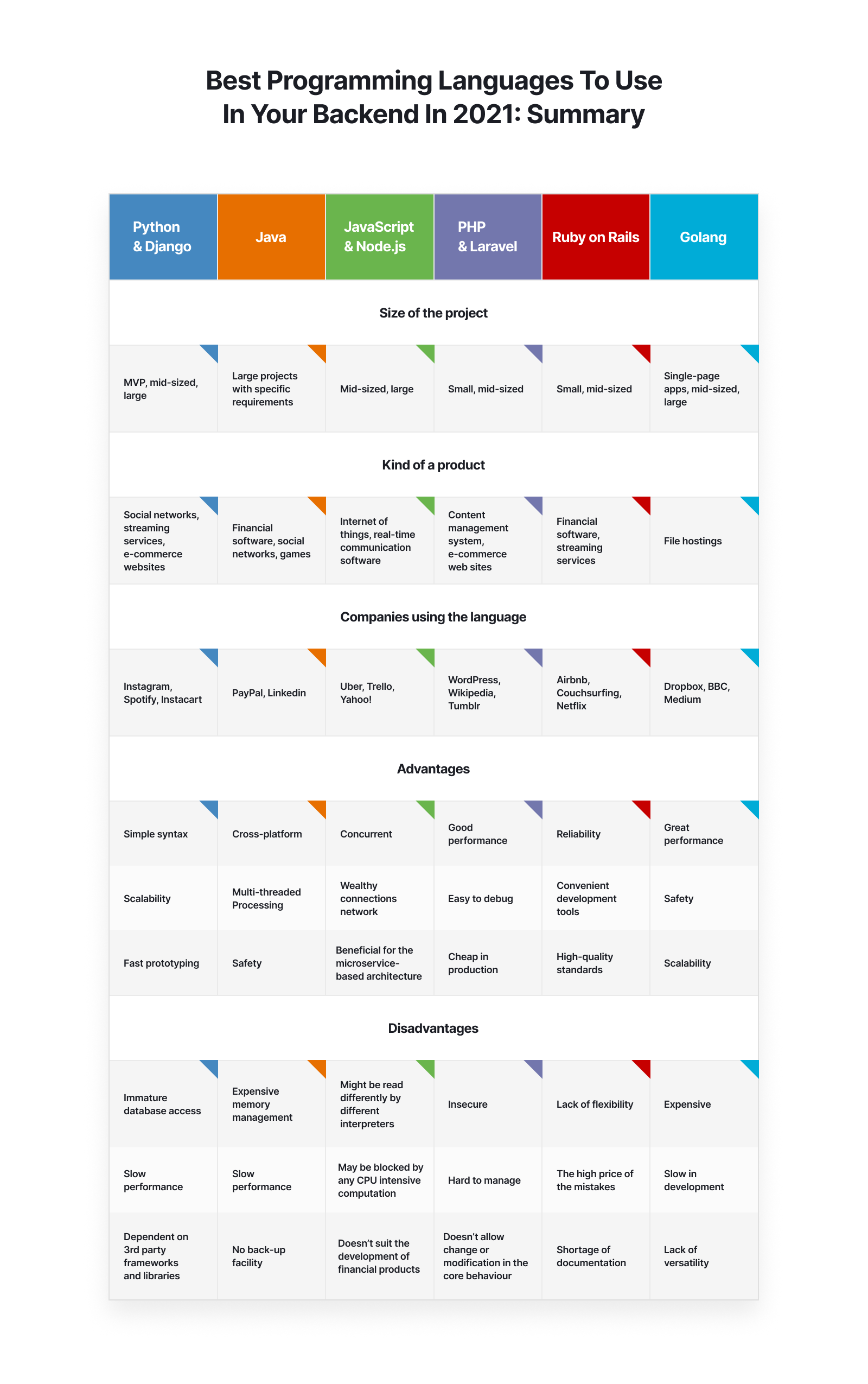
Final Word
To conclude our overview of the best backend language for web development we want to outline that there is no single solution suitable for all kinds of projects. It is always a trade between productivity and demanded resources, scalability and safety, simplicity of production, and effectiveness. If you are not sure which backend development technology will be the best for your project, get in touch with us. Our software consultants will help you define your business needs and pick the right technology and our skilled backend developers matched with your industry and company culture will help you create your product.

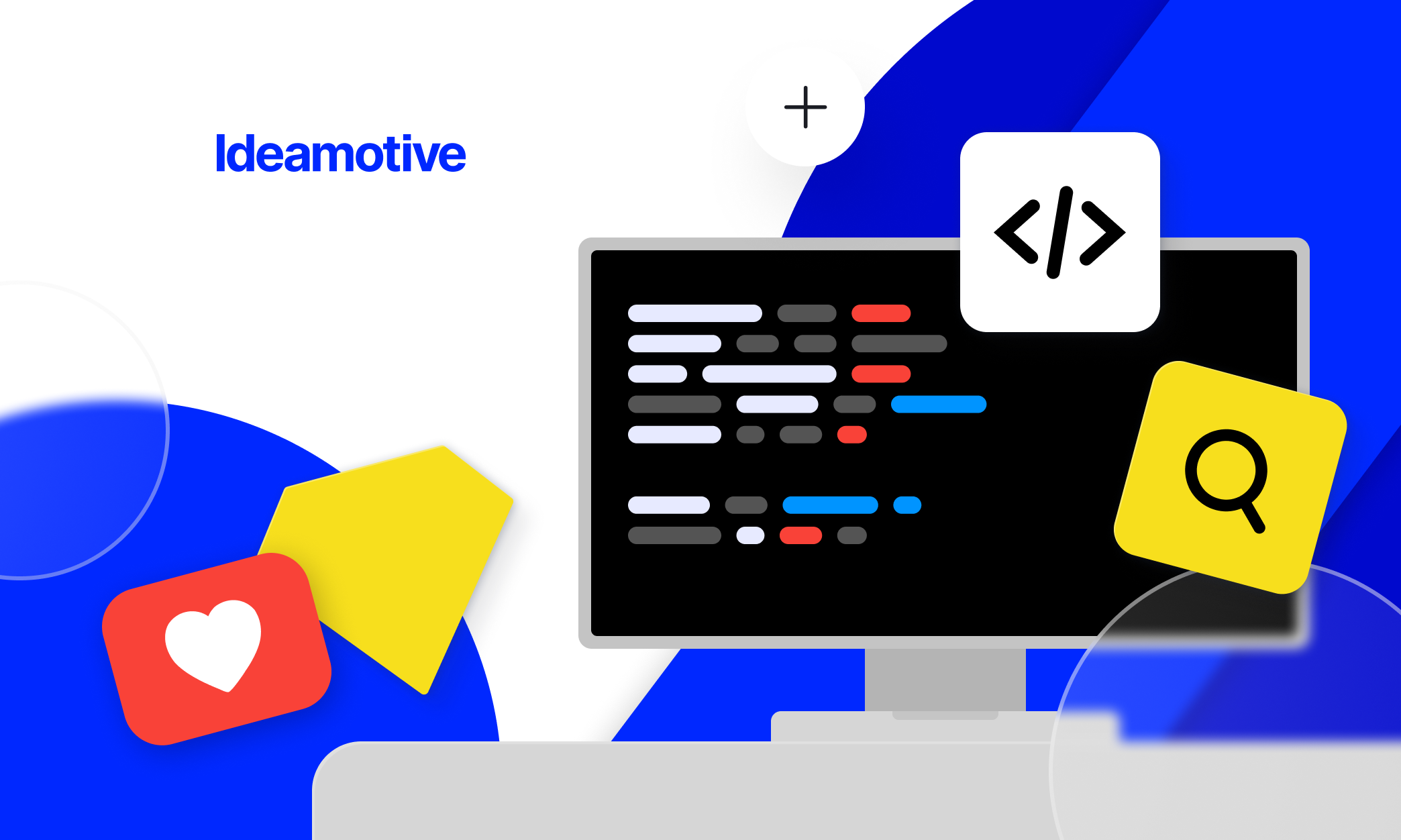


.png?width=1584&name=Python_%20The%20Definitive%20Business%20Guide%20-%20blog%20banner%201584x396%20(1).png)














-1.png)
